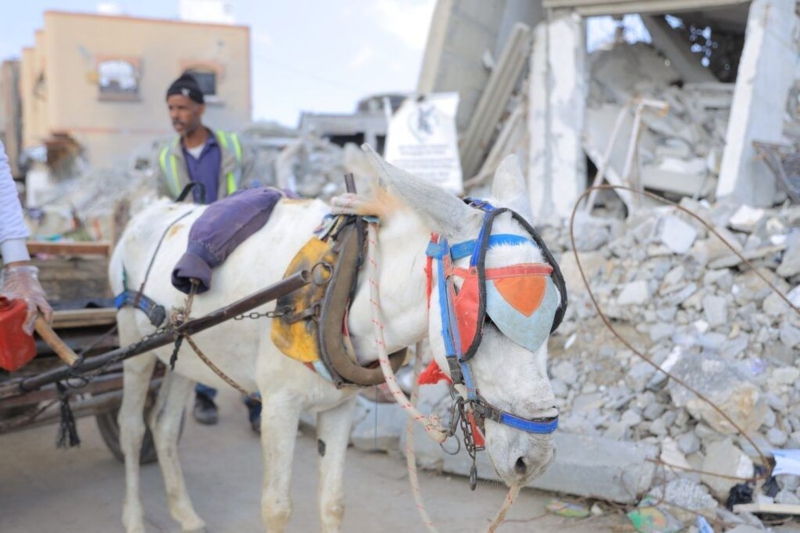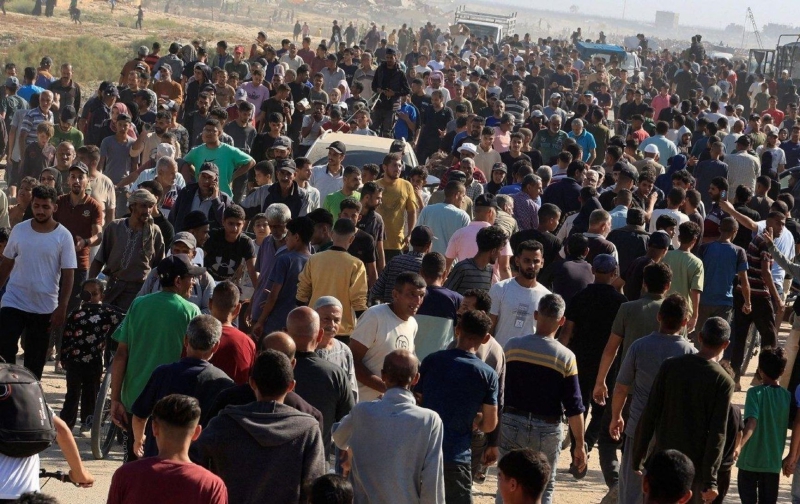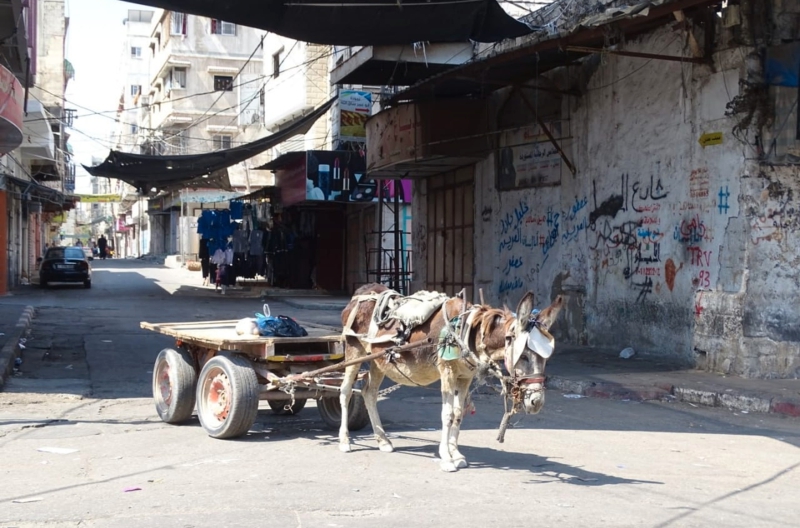announced the start of “tactical pauses” in the Gaza Strip in order to allow for the delivery of aid. The situation inside the enclave is growing increasingly catastrophic. Hunger is rampant, transportation is all but inaccessible, and for hundreds of thousands of Palestinians in Gaza, survival now quite literally depends on donkeys to move both food and people. But like their owners, the donkeys are not spared the horrors of war: they are killed in airstrikes and shelling, suffer from severe shortages of food and medicine, and even show signs of psychological distress. The efforts of Israeli and Western animal rights groups have only added to the humanitarian crisis — evacuating the pack animals from the warzone has left people there even more vulnerable.
Sometimes, the headlines really do tell the story: “Gaza Bombed to Middle Ages,” is not a figure of speech — it is a description of reality on the ground in the embattled enclave. ” The most visible example is in the area of transportation. Every day, there are fewer cars on Gaza’s roads. The Israeli blockade has cut off the supply of spare parts and fuel, making vehicles increasingly hard to repair and, often, impossible to operate. Even when a car is still able to run, driving has become dangerous in itself: civilian vehicles are often targeted by Israeli forces. As a result, animal-powered transport has taken over, and donkeys are leading the way.
Pack animals have replaced not only private cars, but also the trucks once used to deliver food and even construction materials. In some cases, they even serve as ambulances. The wounded and the sick are now transported to the few remaining hospitals still operating in Gaza in carts pulled by donkeys and mules. According to the British charity Safe Haven for Donkeys, whose representatives work inside the enclave, 90% of Gaza’s residents depend on donkeys as their only means of getting food and medicine. The animals are even honored in festivals thanking them for their service.

Donkeys are remarkably low-maintenance animals. Barley feed — the staple of their diet — has always been far easier to come by than gasoline or diesel. Before the war, a liter of fuel cost between $1.50 and $2, while a sack of barley — enough to last several days — cost less than a dollar. And unlike vehicles, the animals’ ability to work doesn’t depend on spare parts.
Every day, donkeys save the lives of thousands of Palestinians. The bitter irony is that the vast majority of these animals were brought into Gaza from Israel. There are no local farms in the enclave that breed pack animals, and until fairly recently, hundreds of donkeys were supplied annually from the Israeli side. However, that trade stopped in 2021 after Israel accused Palestinian buyers of sending young, healthy donkeys across the border to Egyptian slaughterhouses to profit from the sale of their meat and hides. Palestinians denied the allegations, and no direct evidence of mistreatment toward the animals sent to Gaza was ever presented. Even so, Israel has not shipped donkeys to the enclave for the past four years.
Donkeys save the lives of thousands of Palestinians — yet the vast majority of them were brought into Gaza from Israel.
According to UN data from August 2024, a year ago 43% percent of all working animals in the region had already been killed or else died from wounds and disease following the start of the war. At that time, the number of surviving donkeys, horses, and mules in Gaza was estimated at 2,627. It is clear that, due to the ongoing fighting and a continuing blockade, the number of animals has fallen even further. Meanwhile, their prices have skyrocketed. Just two years ago, a young, healthy, working donkey could be bought for no more than $200–$300. By 2024, the price had risen to at least $800, and today it stands at around $3,000. Barley feed has also surged in price — from 90 cents to $15 per sack.
Once a cheap alternative to cars — which most Gaza residents could not afford even in relatively good times — donkeys have now become both an unaffordable necessity. Often, they provide the only remaining lifeline for supplying the besieged territory.
With each passing day, donkeys in Gaza are becoming ever more scarce. Many animals die in Israeli airstrikes, and many more suffer from treatable illnesses due to an Israeli ban on the import of medical equipment. But there is also another factor at play: donkeys are also being evacuated — or, as Palestinians describe it, stolen — and transferred to shelters in Europe. Right now, the non-profit Network for Animals is raising funds to remove fifty donkeys from the enclave. A few months ago, thanks to the organization’s efforts, 58 animals were taken out of Gaza. They are now in Belgium and France.
Representatives of Network for Animals do not disclose exactly how the animals are removed. However, it can be assumed that the donkeys are taken from areas of Gaza occupied by the IDF, transferred into Israel, and then flown to Europe. This theory is supported by the fact that Israeli sources themselves say they are taking animals out of Gaza, calling it “an act of mercy.” Palestinian media reject that description. They claim that Israelis are not rescuing donkeys from the ruins of Gaza’s urban neighborhoods, but instead are stealing them from their rightful owners. Moreover, Gaza’s critical dependence on pack animals gives Palestinians grounds to argue that the removal of livestock is part of Israel’s plan to worsen the humanitarian crisis in the enclave.
Gaza’s critical dependence on pack animals gives Palestinians the grounds to argue that the removal of livestock is part of Israel’s plan to worsen the humanitarian crisis in the enclave
Israeli authorities make little effort to hide it: they would welcome the departure of Palestinians from the Gaza Strip. Moreover, Israel’s current Minister of National Security, Itamar Ben-Gvir, has openly stated that he considers it necessary to occupy the entire enclave and force its Arab residents to migrate by blocking humanitarian aid and taking other steps to exacerbate the ongoing crisis.
The Israeli army has declared more than half of Gaza’s territory a zone where Palestinians are prohibited from entering — under threat of death. In the south of the Strip, Israel has set up camps for displaced people, and in these locations, food and medical assistance are available. Israeli media refer to these places as “humanitarian towns.” But in Gaza, across the Arab world, and even among Israel’s own domestic opposition, these camps are viewed with deep suspicion.
First, every potential resident of a “humanitarian town” is subject to thorough vetting for possible involvement in hostilities against Israel — a process that, for many, is intimidating enough to keep them from even attempting to enter. Second, leaked documents referring to the camps as “Humanitarian Transit Zones” suggests they are intended only as temporary shelters from which people will eventually be sent elsewhere, most likely abroad.

The General Staff of the IDF insists that its forces have not been tasked with expelling Palestinians from Gaza. Prime Minister Benjamin Netanyahu, however, is more circumspect. In early July, he described the choice before Gaza’s residents, saying: “People can stay if they want, but if they want to leave, they should have that opportunity.” It is clear that the fewer donkeys remain in Gaza, the harder it will be for Palestinians to access food and medicine — a situation that will inevitably increase the number of people opting to leave the enclave. In this sense, the removal of working animals could indeed be part of a broader plan to deepen the humanitarian crisis.
The apparent aim of Prime Minister Netanyahu and Minister of National Security Ben-Gvir to encourage Palestinians to leave Gaza still faces several obstacles — the biggest being the firm refusal of Israel’s Arab neighbors to take in more refugees. In addition, Palestinians continue to find ways to resist pressure and survive under extreme conditions. Unlike the animal rights groups that are removing animals from Gaza, the aforementioned British charity Safe Haven for Donkeys is among those helping the Strip’s residents by saving their livestock. One of its local veterinarians, Saif Alden, has set up a mobile veterinary clinic that treats animals free of charge.
“Donkeys and other pack animals are absolutely essential for daily survival in Gaza, especially during times of war and blockade. With roads destroyed, fuel extremely scarce, and vehicles either non-functional or targeted by gunfire, donkeys become a lifeline for many families, farmers, and humanitarian workers,” the doctor told The Insider.
“Many families in Gaza have told us openly: ‘If our donkey dies, we will die too.’ These animals are not just tools for survival — they are partners. They stay by people’s side amid the ruins, in places no vehicle can reach. In Gaza, where the lives of both humans and animals are under threat, the survival of one is tied to the survival of the other.”
Due to the shortage of fuel and spare parts for vehicles, staff from the mobile clinic are forced to travel by bicycle — or even on foot, carrying equipment in backpacks and bags. On its very first day of operation in 2024, the clinic’s veterinarians treated as many as thirty donkeys. Dr. Saif said the animals suffer from malnutrition, physical injuries, and psychological trauma brought on by the fighting.
{{image_Hmon55Ytzd}}
“Many animals — donkeys, horses, sheep, goats, dogs, cats — have no access to food or clean water. We’ve found some that haven’t eaten for days, even weeks, scavenging for scraps among rubble and garbage or surviving on contaminated water,” the veterinarian said. “We’ve seen horses with shrapnel wounds, donkeys with broken legs, cats with burns, and dogs missing limbs. Without proper care, even minor injuries become fatal. At the same time, veterinary services are often overwhelmed or entirely unavailable. The animals’ physical suffering is compounded by psychological trauma, which manifests outwardly as trembling, disorientation, aggression, or complete withdrawal.”
The weekly cost of running the mobile clinic depends on several factors: the price of medicines, the areas the veterinarians are able to reach, and the mode of transportation — on foot, by donkey cart, or, in rare cases, by car. According to Dr. Saif, the organization’s overhead comes to around $2,000 per week. This amount covers medical supplies, emergency treatment, transportation, and operating expenses.
Running the mobile clinic in Gaza costs around $2,000 per week.
“We focus on the most urgent cases — because there’s no other choice. Many areas are now completely inaccessible due to ongoing fighting,” Alden said. “These are red zones, far too dangerous to travel to, yet they are full of animals we want to help. Despite the restrictions, we do our best to make every dollar count, because every life matters.”
Despite its name, Safe Haven for Donkeys helps a wide variety of “patients,” including cats, dogs, and poultry. But the main patients are working animals — without them, Gaza’s already dire humanitarian crisis would be even worse.

